

福山一光 — Kami Ya Co.,Ltd. Les Herbes de l'éternité - Editions Picquier. Traduit par Manuela Moscatiello Illustré par SEKKA Kamisaka Version souple du coffret paru en 2013.
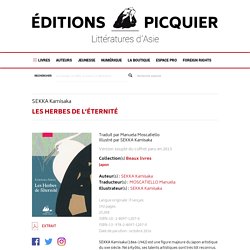
An Amazing 1903 Guide to Wave Designs for Japanese Craftsmen is Now Available Online FOR FREE - artFido. BachmannEckenstein JapaneseArt. □ okuhara seiko. Yumeji Takehisa. 北斎漫画のルーツ!ゆるくてかわいい鍬形蕙斎の「略画式」 Tsukioka Yoshitoshi - One Hundred Aspects of the Moon: The Yugao Chapter from The Tale of Genji. Suzuki Harunobu. The Androgynous 'Third Gender' Of 17th-Century Japan. Fukuda Kodojin (1865-1944) - Hanging Scroll (Kakemono), Japan, Showa (1926 - 1989) - Alain.R.Truong. Fukuda Kodojin (1865-1944) - Hanging Scroll (Kakemono), Japan, Showa (1926 - 1989) Ink on paper - H: 129.2 cm (51 inch); W: 31.4 cm (12 1/4 inch) - Mounting (Hyogu) 197 x 44 cm - Original box (Tomobako)
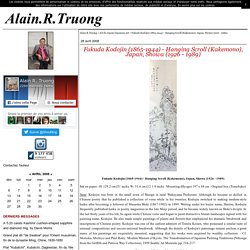
Fukuda Kodojin (1865-1944) - Hanging Scroll (Kakemono) on BachmannEckenstein. Detail: Larger picture Reference: (download) Stephen Addiss, Old Taoist: the Life, Art and Poetry of Fukuda Kodojin (1865-1944), Columbia University Press, 1999Morioka, Michiyo and Paul Berry: Modern Masters of Kyoto.
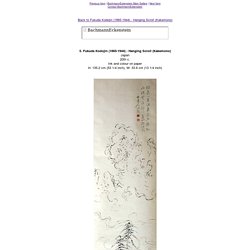
The Transformation of Japanese Painting Traditions (Nihonga from the Griffith and Patricia Way Collection), 1999 Seattle Art Museum, pp. 216-217 Links to collections of Kodojin's work: Manyo'an Collection - Gitter-Yelen Art Study CenterClark Center for Japanese Art and Culture. RARE Japanese SCROLL PAINTING, FUKUDA KODOJIN (item #307972) Sold, Thank you Offered here an ink landscape on paper by the eccentric and highly sought Japanese artist Fukuda Kodojin (1865-1944) dated 1919.
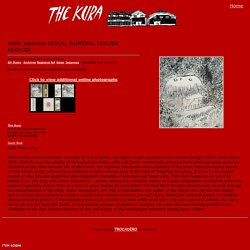
Birds fly over the stubble of harvested rice fields, while odd thatch-roofed huts sprouting from wind beat grass focus our attention on the dark forested left of the scene. The vigorous brushwork and complexity of the scene belie the typical scenes of cold winter death, and seems to intimate a hidden energy busy at the task of Preparing for spring. It is set in an unusual border of olive brocade patterned with manjirushi (symbols of eternity) and flower dials. Iwao Akiyama. Japanese visual artist Iwao Akiyama was born in 1921 in Southern Japan.
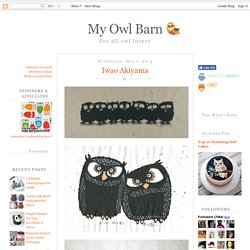
He learnt drawing from a Buddhist monk as a child. He was originally trained in oil painting and later studied woodblock with Shiko Munakata for about six years. Japanese woodblock prints art paintings owls cats gallery - Iwao Akiyama. Viewing Japanese Prints: Yoshida Masaji woodblock prints. Yoshida Masaji (吉田政次) was one of the most prominent pupils of Kôshirô Onchi.
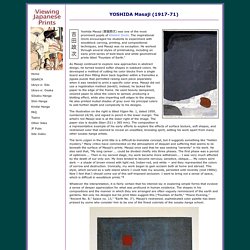
The inspirational Onchi encouraged his students to experiment with woodblock carving, printing, and compositional techniques, and Masaji was no exception. He worked through several styles of printmaking, including an early print series of bold black and white geometrical prints titled "Fountain of Earth. " As Masaji continued to explore new approaches in abstract design, he turned toward softer shapes in subdued colors.
He developed a method of cutting his color blocks from a single board and then fitting them back together within a framelike a jigsaw puzzle that permitted raising each piece separately when it was needed to print a specific color area. Masaji did not use a registration method (kentô); instead, he tacked the paper to the edge of the frame. The illustration on the right is titled Yûgen No. 1, dated 1959, numbered 24/30, and signed in pencil in the lower margin.
Collections Database. Mieko Kawakami, la Japonaise qui monte - 19 mars 2012. Elle est la fille d'une mère solitaire, qui cumulait les petits boulots dans les supermarchés d'Osaka.

Quand Mieko Kawakami a annoncé à sa mère Rié que son premier roman avait été choisi pour figurer sur la liste du plus prestigieux prix littéraire du Japon, le prix Akutagawa - une timbale qu'Haruki Murakami n'a, par exemple, jamais décrochée -, celle-ci croyait qu'il s'agissait d'un concours hippique. Il n'était pas dit, on le voit, que Mieko ferait carrière dans la littérature. D'autant qu'elle avait démarré dans la mauvaise, faisant l'hôtesse dans un club des quartiers nord d'Osaka. Et payant ses cours de philo par correspondance et la scolarité de son frère avec ses cachets de musicienne rock. Sōtatsu: Making Waves. October 24, 2015‒January 31, 2016Arthur M.
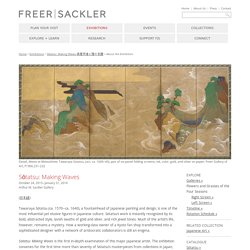
Sackler Gallery (日本語) Tawaraya Sōtatsu (ca. 1570‒ca. 1640), a fountainhead of Japanese painting and design, is one of the most influential yet elusive figures in Japanese culture. Sōtatsu’s work is instantly recognized by its bold, abstracted style, lavish swaths of gold and silver, and rich jewel tones. Much of the artist’s life, however, remains a mystery.
Sans titre. THE BLUE LANTERN: Mandarins: Akutagawa Ryunosuke & Tanaka Ryohei. "I simply wanted to write novels divorced from reality.

" - Akutagawa Ryunosuke A certain kind of person experiences life through literature. Ryonosuke Akutagawa (1892-1927) was one of those and in his stories reading is often used as a plot device. “From Anatole France he shifted to the 18th century philosophers. But he avoided Rousseau. One side of his nature, - a side easily swayed by passion, was perhaps already too near Rousseau. Images of a Changing World: Settai Komura (1887–1940)
Hydrangea and Swallow - Katsushika Hokusai. Verne Collection - Koshiro Onchi. You are here > Online Catalog > Koshiro Onchi > Artist Biography Onchi Koshiro is considered one of the leading innovative figures among Japan's twentieth-century artists.

He is credited with producing Japan's first purely abstract work Light Time in 1915. He produced single sheet prints and book designs, as well as being a poet and art theorist. He began his career learning oil painting at the Tokyo School of Fine Arts, going on to study sculpture, which he later abandoned. In 1911, under the influence of Takehisa Yumeji (1884-1934), Onchi began to design books and quickly became involved in producing print and poetry magazines.
RENGETSU. Kimura. Old Taoist: The Life, Art, and Poetry of Kodojin (1865–1944) Fukuda (Haritsu) Kodōjin (1865–1944) was part of the long tradition of Japanese literati poet-painters. While the Chinese literati ideal as it was understood by Japanese painters and poets of the nineteenth century was not particularly concerned with popularity or communicating to the masses, by Kodōjin’s time it must have been clear that the tradition had become an artifact of an earlier era. Cent vues d'Edo. Rencontre: avec les chats de Shozo Ozaki, mon ami japonais.
Nihonga. Ikenaga Yasunari - The Japanese Art of Nihonga Redefined. Using the simplicity of indian ink and linen canvas Ikenaga Yasunari has captured a simple serenity in the the faces of his female portraits.This calm sensuality is highlighted by the richness of their surroundings. Yasunari’s Japanese heritage has inspired a style of painting which is characteristic in his work. This ancient technique of Nihonga is a traditional Japanese artform using a Menso brush and ink. Yasunari ikenaga, delicadeza japonesa. Empezamos el domingo suavemente hablando del artista Yasunari Ikenaga (1965). El pintor japonés realiza obras que representan a mujeres hermosas, cuyas expresiones y posturas sugieren una atmósfera de ensueño.
Ikenaga, que también muestra exquisitos patrones de diseños textiles en sus pinturas, tiene como tema principal a mujeres actuales, pero al mismo tiempo, el estilo de su pintura refleja las antiguas tradiciones japonesas, dando a sus obras una sensación de atemporalidad. Su trabajo destaca por esa unión de tradición y modernidad, lleno de armonía, belleza y sensualidad femenina. IKENAGA YASUNARI. Nihonga. Nihonga 日本画 « Notes, Essays, Discovering Nihonga Artists in Japan and around the World.
~ Japanische Maler ~ 横山大観『作右衛門の家』 甲斐庄 楠音 Tadaoto Kainosho. 横櫛 1920Yokogusi 島原の女(京の女)1920Woman of Simabara(Woman of Kyouto) 春宵(花びら)1921Spring Night I went to the bookstore today. Then, the draw collection that I do not want to see has been seen. Ogata Gekko. Ogata Gekko. Yumeji Takehisa. Nagao. The talented women of Kyoto. “Women Artists of Kyoto: Bearing Burdens / Burdens Born” is ostensibly about the classification of female artists since the late 19th century. The term “keishu-gaka” refers to accomplished women artists, “joryu-gaka” to post-World War II artists who created trends among male colleagues and “josei-gaka” simply emphasizes the feminine gender of an artist. Distinguishing between male and female interpretations of art has been historically important in Japan, and remains so.
In the 1990s, the critic Kotaro Iizawa gave the name “onnanoko shashinka” (girl photographers) to an emergent generation of female artists with a penchant for taking brightly-colored photographs of everyday and intimate scenes. The visual thrust of this exhibition, however, concerns the larger theme of the way female artists have represented women in accord with their times. 三重県立美術館/KIKUCHI Keigetsu. the 130th Anniversary of his Birth. KIKUCHI Keigetsu(1879-1955) is known as a Japanese-style painter whose figure painting expresses at the same time gracefulness and assuredness. Keigetsu was active in Kyoto from the latter half of Meiji period till the beginning of Showa period, but his works still attract us more than 50 years after his death. Keigetsu was born at the present Nakano city of the Nagano prefecture, and there learned southern-style painting from KODAMA Katei.
On 1896 he went to Kyoto and became a pupil of KIKUCHI Hobun next year. He learned authentic discipline based on Shijo school, and winning various prizes, came into public attention as a promising painter in the artists’ world of Kyoto. After traveling in Europe, he constantly produced serene and graceful works harmonizing occidental painting and Yamato-e, and established his position. Simultaneously we provide a section featuring UDA Tekison, born at Matsuzaka and one of Keigetsu’s pupils. Catalogue. Kajiwara Hisako:Japanese Beauty - Collections - Watanabe Japanese Fine Arts. Une brève présentation de la peinture japonaise - Nihonga. À l'époque Meiji, l'impact de l'art occidental sur le Japon fut immense.
Face à cette invasion un mouvement "loyaliste" prit forme, tentant de défendre l'art traditionnel nippon. À Tokyo, on retrouve Kikuchi Yosai, un peintre éclectique combinant les styles Kano et yamato-e, familier des techniques chinoises et occidentales. À Kyoto, ce sont les peintres des écoles Maruyama-Shijo et Nanga qui formeront le fer de lance du mouvement. Si les premiers auront sur la génération suivante une grande influence, les derniers, d'inspiration confuséenne, disparaîtront victimes des nouvelles valeurs privilégiées par le pouvoir. Bijin paintings. Nihonga : art de la peinture asiatique japonaise. À l'époque Meiji, l'impact à l'art occidental sur le Japon fut immense. Face à cette invasion un mouvement ' loyaliste ' prit forme, tentant à défendre l'art conformiste nippon. À Tokyo, on retrouve Kikuchi Yosai, un peintre éclectique combinant les styles Kano et yamato-e, familier des méthodes chinoises et occidentales.
À Kyoto, ce peuvent être les peintres des écoles Maruyama-Shijo et Nanga qui formeront le fer à lance du mouvement. Si les premiers auront sur la production suivante une grande influence, les derniers, d'inspiration confuséenne, disparaîtront victimes des nouvelles valeurs privilégiées avec le pouvoir.D'une façon ou d'une autre, la tradition se perpétua avec une nouvelle production d'artistes. For Japanese women painters, elegance came at expense of individuality. “Painted by Women: Elegance of Showa Period” announces a thematic concern of the time, 1926-89, on which the art world was rigidified. Japan had embarked upon a 15-year period of war (1931-1945) and the individual expressive liberties that had informed the Taisho Era (1912-26), were being reined in. Notification. New Page 3. Results for 'spider' - Ukiyo-e Search.
Person. [ . BACK to DARUMA MUSEUM TOP . ] ::::::::::::::::::::::::::::::::::::::::::::::::::::::::::::::::::::::::::::::::::::::::::::::::::::: boozu 坊主 priestoshoo 和尚 priestnyuudoo 入道 Nyudo priest shoonin, shônin 上人 saint, head priest of a temple daitoko 大徳(だいとこ)daitoku だいとく priest of high standard soojoo. sôjô 僧正 high-ranking priest, "archbishop" see below Daruma Oshoo だるま和尚 Priest Daruma. 古美術石泉-書画-ご注文・お問合せ. La peinture et l’écriture ― Les kanji de Van Gogh et les ranji d’Eisen ― 1. L’écriture dans la peinture L’écriture est bien plus présente dans la peinture que nous ne l’imaginons : le panneau d’un magasin dans un paysage réaliste, le titre d’un livre à la main d’un penseur dans un portrait, l’étiquette d’une bouteille de vin dans une nature morte, etc… Les exemples ne manquent pas. Le but de l’écriture et son effet varient selon les genres et les peintres.
Mais quels que soient les éléments tels que l’époque, le lieu ou le style, qui précisent le contexte du tableau, l’écriture ne manque pas de s’imposer au spectateur et de l’inviter à la déchiffrer. Dealer & Consultant in Japanese Art.
Fumi Koike. Artistes【アーティスト】 - Tokyo <-> Paris Culture du japon en français 日仏語でフランスと日本の情報発信サイト [Bisou japon]